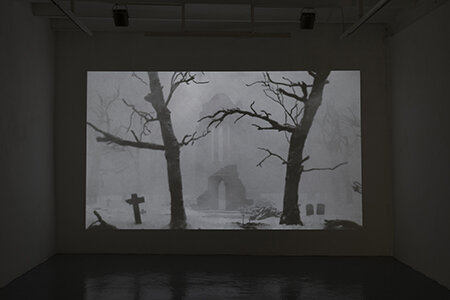South of Heaven
Solo Exhibition
ADN Galeria, Barcelona
May 20 - Aug 31. 2017
Escape is a Hoax, sculpture 2017, Photo Roberto Ruiz
Installation view, Photo Roberto Ruiz
Installation view, Photo Roberto Ruiz
Installation view, Photo Roberto Ruiz
Lament, sculpture, Photo Roberto Ruiz
Installation view, Photo Roberto Ruiz
Installation view, Photo Roberto Ruiz
After Friedrich, sculpture 2017
After Friedrich, sculpture 2017
After Friedrich, sculpture 2017
“We learn from history that we do not learn from history”
Friedrich Hegel
ADN Galeria is pleased to present South of Heaven, an installation by artist Tobias Bernstrup (Sweden, 1970). The Swedish artist takes as a starting point the painting Monastery Graveyard in the Snow (Friedhof im Schnee), by romantic painter Caspar David Friedrich (1770-1840). The painting was destroyed in 1945 in the bombing of Berlin by the allies in the last stages of World War II. The only remaining evidence of the painting is a black and white photograph. Along with the installation Bernstrup will display some sculptural works, including Belief, a scaled model made by Bernstrup that features the grounds of several bombed buildings. The ruins evoke the destruction of a fictive place that acts, at the same time, as a kind of memory.
Bernstrup shows how time shapes memory and oblivion. Friedrich’s Monastery Graveyard in the Snow unsettles because it represents a place that is both familiar and unknown. As with his painting The Abbey in the Oakwood (the most similar to Monastery Graveyard in the Snow), it situates the viewer outside of a defined place and time, and introduces an unnatural, oneiric and sinister landscape. The painting captures an old and deteriorate cemetery, marked by silence and loneliness, under the inclement winter snow. The work evokes the romantic concern towards death and transit. In Monastery Graveyard in the Snow, mankind is somehow circumstantial. It is also present in its absence. The graveyard path, representation of corporeality, is accompanied by oaks, symbol of death but now lifeless under the winter lethargy. Monastery Graveyard in the Snow represents the connection between world and nature in a wholesome way, where materiality decays, part of an endless cycle.
Bernstrup takes the essence of the painting to meditate, as the German painter, about death, transit and disappearance. Monastery Graveyard in the Snow does not represent the beauty or majesty of the landscape. Whoever watches it is forced, instead, to face an isolated self in a void amidst the ruins. The painting shows what remains after it is forgotten, outside of society and its original use. Bernstrup takes this concept of “remains” and extends it to the action of man and the weight of history, in a similar manner to Paul Klee’s Angelus Novus. Monastery Graveyard in the Snow, incarnation of the romantic dream, was destroyed in the bombing of Berlin in 1945. After the painting’s annihilation, its significance has been linked inevitably to this fact, and to memory. Now it invites us to think beyond its pictorial meaning, being linked to war, violence and disappearance. The video South of Heaven captures this wholeness by adding special effects to the painting and adding some scenes.
For the video, Bernstrup recreated the model and type of planes used during the bombing that destroyed the painting. The outcome is a transformation of the instant captured by Friedrich into a process -similar to history-, and we, as spectators, are invited to join it.
There is a certain uncanniness regarding the buildings of Bernstrup’s scaled model, Belief. These are unrecognizable, but we can identify with them. As Klee’s angel, pushed forward to the future without knowing what will happen, Belief also looks at the past. And, as the progress mentioned by Walter Benjamin, Belief is also sustained in destruction. We don’t know what the ruins represented or what they were, but we know what they represent and are now. As Marc Aug says in Le Temps des Ruines: “this lack, this void, this distance between the old perception and the current perception”. Belief shows the vestiges of a building that was -a home, a house, a place that had a use and a habit-, defined by what is left of it. A reminder about what archeology tells us: ruins are, in essence, the degradation of some values that are not contemporary anymore.
The difference between what Aug says and Bernstrup’s installation is that South of Heaven does not show the splendor of an ancient time, but the opposite of that. As it does not restitute any past, Bernstrup poetically strays his gaze to human acts and the nonsense of destruction. This is, in turn, something that our current context explains by itself in light of the EU’s critical fragmentation. There is no delight in contemplating South of Heaven, as it tells of a devastating experience in time, marked by devastating human action. Bernstrup pushes for an awareness of history instead; he makes us remember that what remains is what we haven’t destroyed yet. Belief looks into the future without revealing what is yet to come: this is more a matter of faith.
- Aug , Marc. El Tiempo En Ruinas. Barcelona: Gedisa, 2003.
- Benjamin, Walter (1940). On the Concept of History. En Selected Writings, vol. 4, ed. Howard Eiland and Michael W. Jennings, trans. Edmund Jephcott et al. Cambridge: Harvard University Press, 2003.










